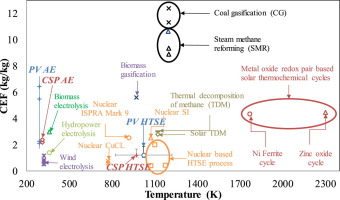Applied Energy ( IF 11.2 ) Pub Date : 2020-01-24 , DOI: 10.1016/j.apenergy.2020.114503 Deepak Yadav , Rangan Banerjee

|
This paper assesses the viability of the solar-based high-temperature steam electrolysis (HTSE) process by estimating the cumulative energy demand (CED) and carbon emission footprint (CEF) of hydrogen. In the analysis, photovoltaic (PV) and concentrated solar power (CSP) plants are considered as the source of electricity. The trend of variation in CED and CEF with the changing temperature and current density of the solid oxide electrolyzer is obtained. The requirements for the feasibility of the HTSE process is established by comparing the results with the solar-based alkaline electrolysis process. Monte Carlo simulation is done to capture the effects of data and performance uncertainties. The carbon footprint of the solar-based high-temperature and alkaline electrolysis processes are also compared with the renewable, nuclear and hydrocarbon-based routes for hydrogen production. The CED of the PV and CSP based HTSE processes are 15.1–28 MJ/kg of hydrogen and 18.8–30.1 MJ/kg, respectively. This implies a net energy gain of 90–104 MJ/kg of hydrogen. The carbon footprint of the PV and CSP driven processes are 1.03–1.87 kg CO2/kg of hydrogen and 1.05–1.67 kg/kg, respectively. The carbon footprint of the steam methane reforming (SMR) process, solar-based alkaline electrolysis, and thermochemical cycles are 10.6 kg/kg, 2–2.3 kg/kg and 4.3–4.5 kg/kg respectively. Thus, the solar-HTSE process is a sustainable alternative not only to the SMR route but also to other solar technologies like alkaline electrolysis and thermochemical cycles. It is recommended that the solar-HTSE route should be further explored by demonstrating the technology on a pilot scale.
中文翻译:

高温电解法生产太阳能氢的净能量和碳足迹分析
本文通过估算氢气的累积能量需求(CED)和碳排放足迹(CEF)来评估太阳能高温蒸汽电解(HTSE)工艺的可行性。在分析中,光伏(PV)和聚光太阳能(CSP)厂被视为电力来源。得到了随着固体氧化物电解槽温度和电流密度的变化,CED和CEF的变化趋势。通过将结果与基于太阳能的碱性电解工艺进行比较,确定了HTSE工艺可行性的要求。进行了蒙特卡洛模拟,以捕获数据和性能不确定性的影响。还将太阳能高温和碱性电解过程的碳足迹与可再生能源进行了比较,核和烃基制氢路线。基于PV和CSP的HTSE工艺的CED分别为氢气的15.1–28 MJ / kg和18.8–30.1 MJ / kg。这意味着氢的净能量增加为90-104 MJ / kg。PV和CSP驱动过程的碳足迹为1.03-1.87 kg CO氢气2 / kg和1.05-1.67 kg / kg。蒸汽甲烷重整(SMR)工艺,基于太阳的碱性电解和热化学循环的碳足迹分别为10.6 kg / kg,2-2.3 kg / kg和4.3-4.5 kg / kg。因此,太阳能-HTSE工艺不仅是SMR路线的可持续替代方案,而且还是其他太阳能技术(如碱性电解和热化学循环)的可持续替代方案。建议通过在试验规模上展示该技术进一步探索太阳能-HTSE路线。



























 京公网安备 11010802027423号
京公网安备 11010802027423号